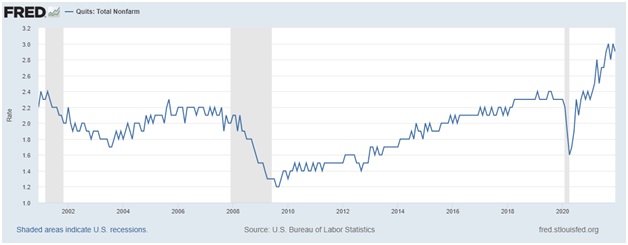A Coaching Power Tool By Rob Hands, Leadership Coach, SINGAPORE

Shifting From Being an ‘Individual’ to Becoming a ‘Leader’: From Me vs. We
In the aftermath of the Covid -19 pandemic, the world is witnessing a changing landscape for employees and employers across the corporate world.
Increasingly employees are showing their dissatisfaction with their employment as evidenced by record numbers of resignations across the globe.
In June 2021 Anthony Klotz, an Associate professor of management at Texas A&M University’s Mays Business School coined the phrase ‘The Great Resignation’ to describe the record levels of people leaving their jobs, first noted in Spring 2021.
The below graph from FRED Economic Data shows the dramatic upturn in non-farm resignations since 2021:

Since the summer of 2021, a record average of 4 million American workers have quit their jobs every single month.
From Me vs. We: Why?
There are several attributable factors for this ‘mass resignation’ phenomena, many of which are related to the impact of the Covid-19 pandemic, including a shift to working-from-home, a greater desire for a work-life re-balance, greater connectivity, and the round-the-clock demands of a more highly connected world, leading to burnout. These have acted as a catalyst for a fundamental change in approach to working a traditional 9-to-5 job across the global workforce.
Furthermore, these factors have also led to an increase in the levels of dissatisfaction with employers and often a deteriorating relationship between staff and traditional management practices and managers themselves. However, this is not just a recent development. The evidence shows that this rising tension between staff and management pre-dated the Covid-19 pandemic:
A 2018 Udemy study found that nearly half of employees surveyed had quit because of a bad boss and two-thirds believed their boss lacked proper managerial training. This figure is thought to have continued to increase in recent years.
The purpose of this Power Tool is to help improve the standard and develop the art of, effective leadership.
There are several ways to approach this and to help improve the standard of leaders, however, this Power Tool is designed to specifically address one of the most fundamental elements of leadership. This is to focus on helping clients to shift their perspective from thinking of themselves and their own performance to thinking of how best to enable and optimize the collective performance of a team. The shift from thinking of ‘Me’ to ‘We’.
What Is the Problem?
In the corporate world often someone who excels in their role as an individual contributor is promoted to a position of leadership, usually as a reward for high performance in their existing role, rather than necessarily being identified as someone with the skills, capabilities, or potential ability to become a strong leader of people.
To be an effective leader requires a different, often completely opposing, set of skills to that required to be a high performing individual contributor. However, organisations continue to appoint people to leadership positions based on them displaying a high level of non-applicable skills that provide no indication that the individual could develop into a good leader.
This has led to a generally poor standard of management across a breadth of organisations, populated by bosses who fail to optimise the performance of their teams beyond the basic level of performance. In addition to sub-optimal team performance, poor leadership will negatively affect staff morale and motivation (often including the manager themselves) which can result in low productivity and high staff turnover. When good employees leave productivity reduces, morale suffers, and the remaining colleagues struggle with the increased workloads. This amounts to a significant cost to the businesses.
From Me vs. We Leadership Explanation:
When assuming a position of leadership, usually as a reward for high performance as an individual contributor, people are required to change their mindset and develop new behaviours and skills.
One of the key shifts in mindset is to alter the perspective from thinking of ‘self’ to thinking of ‘others’:
Before you area leader, success is all about growing yourself. When you become a leader, success is all about growing others. Jack Welch, Former CEO & Chairman of General Electric
Often new bosses fail to adapt to the demands of leadership. This can be attributed to the very fact that they have demonstrated excellence in the skills required to perform as an effective individual contributor. For example:
If an employee was struggling with an issue, as a subject matter expert in the given area, the boss would step in to help the team member execute that skill on behalf of the employee, rather than trusting the team member to figure it out and perform the task themselves. Thus denying that team member the ability to develop, refine and enhance that skill themselves, and create deeper learning and understanding of the skill that is required.
This is the equivalent of a Coach providing answers to a client during a coaching session, therefore denying the client the opportunity to find the solution themselves and grow as a result.
Another example of the required shift in mindset is the approach to results. As an individual contributor, one received recognition for one’s own personal contribution. However, as a leader one is judged on the collective results of the team. The leader’s job is to support, assist and enable those team members to achieve all their collective goals, not just to focus on their own personal goals.
Furthermore, the goal of a leader needs to be for the team to outperform the sum of its parts e.g., the abilities of the individuals within that team. In high performing teams, the collective output exceeds that of the sum of the individuals. This is the mark of effective leadership.
Difference Between Leaders & Bosses
Every team has a boss but what a successful team need is a leader to help that team achieve their potential as individuals and as a collective group.
What is leadership? The act of motivating other people toward a common goal. People that have leadership skills display their unique personalities and strong interpersonal skills to lead others in their direction.
A boss ‘manages’ their employees, while a leader inspires them to innovate, think creatively and strive for excellence.
Management is about persuading people to do things they do not want to do, while leadership is about inspiring people to do things they never thought they could. Steve Jobs, Former CEO of Apple.
When you were made a leader, you weren’t given a crown; you were given the responsibility to bring out the best in others. Jack Welch, Former CEO & Chairman of General Electric
Key Characteristics of Successful Leaders
The most essential characteristic and “THE significant” factor in separating average teams from high performing teams is the level of trust. For any leader to be successful, it is essential that they create an environment where the individuals have a high level of trust in both the leader and in each other.
Some ways of creating trust and key characteristics of successful leaders include:
Integrity:
- Acting with integrity builds trust – The single most important factor in dictating a team’s success.
- Successful leaders display integrity by living their core values, leading by example, and following through on their commitments and promises.
- Examples of integrity:
- Apologizing for mistakes.
- Highlight the work of the employees and downplay their own contributions.
- Be appreciative of people’s time.
Effective Communication:
- Establishes rapport and openly shares ideas via 2-way communication.
- Simple and direct.
- Honest and transparent.
- Active Listening:
- Pay attention to the individual.
- Make people feel heard.
- Show sincerity through maintaining eye contact etc
Accountability:
- Hold themselves and employees accountable for their actions, which creates a sense of responsibility among the team.
- Give credit where it is due.
- Take the blame when possible.
Empathy:
- Forges a deep personal connection.
- Increases psychological safety and trust amongst the team.
- Improves teamwork.
- Inspires loyalty.
Humility:
- Focus on problem-solving and team dynamics more than self-promotion.
- Prioritise the well-being of the team.
- Vulnerability and humility will make a leader more relatable and effective.
Resilience:
- Maintain a positive attitude in both the good and the challenging times.
- How a leader acts during difficulties will demonstrate their true grit and worth.
- Focus on solutions rather than problems.
Vision:
- “Good business leaders create a vision, articulate the vision, passionately own the vision and relentlessly drive it to completion” Jack Welch, Former CEO & Chairman of General Electric.
Empowerment:
- Leaders must transition from ‘doing’ to ‘leading’.
- Encourages an autonomous environment and decision making.
- Avoids micro-management.
From “Me vs. We” How to Use the Power Tool
The Power Tool would be deployed during a coaching session, either formally or informally via the following line of questioning:
Step 1: Ask the following question:
What does a successful day/quarter/year at work look like?
- If the answer revolves around individual goals and achievements, go to Step 2.
- If the answer revolves around the above listed Key characteristics of successful leaders, then move to Step 3.
Step 2: Alter the definition of ‘success’ by using the following line of questioning:
- What does success look like for an individual contributor?
- What is the difference between a boss and a leader?
- Think of examples of good leadership (not just work, could be sports or any other field). What are the characteristics that stand out?
- What would success look like for an effective leader?
- What does the team need to be successful?
- What does trust mean to you?
- How do you feel when you are in a trusting relationship?
- In what ways can you help others achieve their goals?
- When you think of empowering others, what comes up?
Step 3: Increase Self Awareness:
- Undertake a ‘Values Audit’ to help the leader understand themselves better. This will help them act authentically.
- Often individual contributors fail in their transition to leadership because they try to act as they believe a leader ‘should’. For example, they often replicate behaviour they have seen in other leaders. This is inauthentic.
- They can lack awareness of their own relevant strengths and have not had to utilise nor been aware of the leadership skills they possess.E.g., Communication, ability to influence etc.
- Effective Leaders have high self-awareness and identify and utilise their strengths to develop a style of leadership which ensures authenticity. An essential characteristic for any successful leader.
Step 4: Creating Actions:
Ways to Lead Effectively: From Me vs. We
There are many ways to lead effectively. Some lead through example, some inspire through excellent communication, some lead through selflessness, some through decisiveness, and some through collaboration or delegation. There is no fixed ‘right’ way, but there are certainly ways to do it ‘wrong’. One of the consistent and key elements in successful leaders of high performing teams is how they define success: It is essential that there is a shift in mindset from thinking of Me vs. We.
References
Anthony Klotz, an Associate professor of management at Texas A&M University’s Mays Business School
FRED Economic Data
S. Bureau of Labour Statistics.
Jack Welch, Former CEO & Chairman of General Electric
Steve Jobs, Former CEO of Apple.